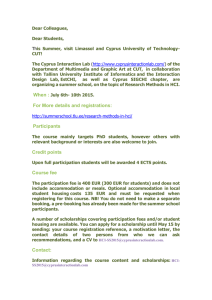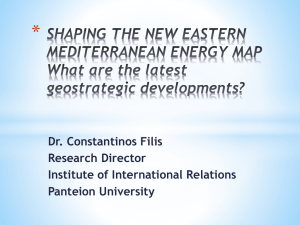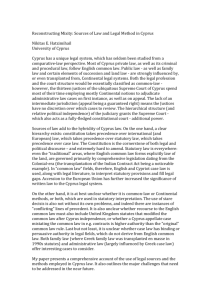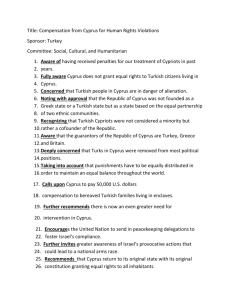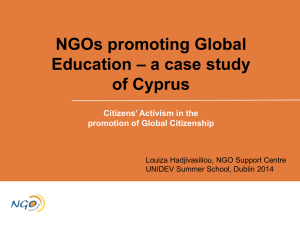in Cyprus
advertisement
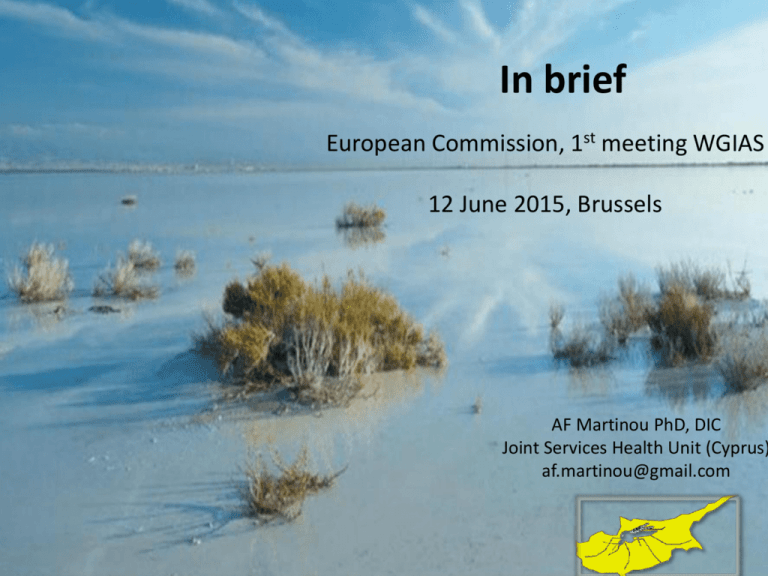
In brief European Commission, 1st meeting WGIAS 12 June 2015, Brussels AF Martinou PhD, DIC Joint Services Health Unit (Cyprus) af.martinou@gmail.com A little bit about me • Entomologist by training • working on invasive pests and invasive biocontrol agents • Impact (direct and indirect) especially in HNV systems • ES provision, biodiversity, pesticides • 2 organizations, 3 countries that released invasive organisms Cyprus Cyprus is • The 3rd largest island in the Mediterranean Propomacrus cypriacus • South-eastern corner of EuropeLevantine area • Varied topography, geology, bioclimate • Biodiversity hot spot • High levels of endemism TSINTIDES TC. 1998. THE ENDEMIC PLANTS OF CYPRUS. Current threats to natural & seminatural systems in Cyprus • • • • • Land abandonment Urbanization Agricultural Intensification Desertification Biological invasions My work • Previous projects • Current projects • Cyprus Invasive Alien Species database Previous work- Deleterious effects of pesticides High Nature Value carob grove Rats + overgrazed carob To promote and enable the long term conservation of High Nature Value Farmlands (HNVFs) in Cyprus Currently • Entomologist at JSHU (Cyprus), RAF Akrotiri • Responsible for the Integrated Vector Management Programme • Managing a team of 40 IPCOs • Akrotiri Peninsula 60 km2 • Important area for Biodiversity- IBA- SPA Great area for mosquitoes • Malaria in the past, eradicated in the late 1950s • Intensive survey and monitoring programme in order to manage existing mosquito species • Be in a position to detect new invasions early!! Mosquito Area Management (MAM) programme Akrotiri Peninsula 60 Km2 Area Survey & Monitoring mosquito scheme Larval Survey recording planning Dip sampling Survey & Monitoring mosquito scheme Adult survey CO2 Trapping Integrated Vector Management Approach • Physical control (water managementdraining) • Biological control • Chemical control • Evidence based • Restoration projects Restoration project Fassouri Marsh • Birdlife Cyprus • Akrotiri Environmental Education Centre • Our role Biological control using endemic fish & Control for invasive Gambusia Gambusia intentionally released in the past Fish population dynamics From my experience • While management of IAS is very important and great to work on (issue 3) • Awareness raising (1) & Development of guidelines and training material for ALL in competent authorities (6) of immense importance Creating CYIAS The Cyprus Invasive Alien Species database AF Martinou1 & A Zenetos 2 1Joint Services Health Unit (Cyprus) 2Hellenic Centre of Marine Research Antalya, 3 November 2014 The gap • IAS national experts & local networks: the foundation for info provision to larger networks and EU policies • Cyprus was lacking such a foundation- (Ad hoc committee EU regulation on IAS) CYIAS aims at 1. Providing an up-to-date centralized information system on the distribution of invasive species for Cyprus 2. Establishing a national network of aquatic and terrestrial experts that will engage in the development and updating of CYIAS 3. Linking IAS issues in Cyprus with European and global databases 1. Providing up-to-date centralized information system on IAS distribution • 155 marine alien species • 15 freshwater species (12 freshwater fish and 3 freshwater molluscs) • and 494 terrestrial species information on pathways, origin, establishment success, first sighting/collection date where available, first citations (literature) 1. Providing up-to-date centralized information system on IAS • List of most invasive species for the Med. region also present in Levantine area, Cyprus • List of marine IAS of commercial importance with information on literature, first sightings, establishment success and consulted databases Most invasive illustrated Atherinomorus forskali Brachidontes pharaonis Caulerpa racemosa var. cylindracea Caulerpa racemosa var. lamourouxi Chama pacifica Cladophora cf. patentiramea Branchiomma bairdi Caulerpa racemosa var. turbinata Dendostrea folium Branchiomma luctuosum Ceratonereis mirabilis Ergalatax junionae Cassiopea andromeda Cerithium scabridum Erugosquilla massavensis Amphistegina lobifera Fistularia commersonii Hydroides heterocerus Pempheris vanicolensis Aplysia dactylomela Apogonichthyoides pharaonis Fulvia (Fulvia) fragilis Lagocephalus sceleratus Penaeus semisulcatus Aquilonastra burtoni Halophila stipulacea Asparagopsis armata Hydroides dianthus Hydroides elegans Lophocladia lallemandii Notomastus mossambicus Percnon gibbesi Pinctada imbricata radiata 1. Providing up-to-date centralized information system on IAS • Highligthed the need for EWRR for fishermen/public Pterois miles- common lionfish Rhopilema nomadica- nomad jellyfish • Not yet present but needs attention Plotosus lineatus 2. Establishing a national network of aquatic and terrestrial experts for CYIAS • Researchers from Universities and research centres from Cyprus and Greece • Policy makers/government officials- Dpt. of Agriculture, Dpt. of Fisheries, Dpt. of Environment • Citizen scientists 3. Linking IAS issues in Cyprus with European and global databases • Full list of validated data on marine species was transferred to DAISIE • List available upon request for EASIN, CABI etc. Thank you very much for your attention

